No 2001-5: The Impact of Bankruptcy Rules on Risky Project Choice and Skill Formation under Credit Rationing
Shubhashis Gangopadhyay and Clas Wihlborg
Additional contact information
Shubhashis Gangopadhyay: Indian Statistical Institute,, Postal: Indian Statistical Institute,
Clas Wihlborg: Department of Finance, Copenhagen Business School, Postal: Department of Finance, Copenhagen Business School, Solbjerg Plads 3, A5, DK-2000 Frederiksberg, Denmark
Abstract: The contribution of this paper is in emphasizing endogenous credit rationing in the
analysis of effects of bankruptcy rules on entrepeneurs’ decisions with respect to risk-taking
and ex ante skill-development. Unlike most of the literature, both the debt claim
and the amount of debt financing is endogenous in our exercise. This allows us to
determine the extent of credit rationing that banks use to tackle informational asymmetry.
Credit rationing is non-trivial and increases the cost of capital when corporations are
forced to access alternative sources of funding even when debt is a cheaper alternative.
We thus solve for optimal debt-equity ratios in the capital structure of the corporation and
entrepeneurs’ risk-taking. Second, we allow entrepeneurs to invest in generating skill to
handle risky projects. We show that bankruptcy policies are important determinants of
all these outcomes in ways that in some cases contradict the existing literature, which
does not consider endogenous credit rationing.
Keywords: credit rationing; Bankruptcy rules; Financing
JEL-codes: A10
32 pages, August 1, 2001
Full text files
7162
Questions (including download problems) about the papers in this series should be directed to Lars Nondal ()
Report other problems with accessing this service to Sune Karlsson ().
RePEc:hhs:cbsfin:2001_005This page generated on 2024-09-13 22:14:14.

